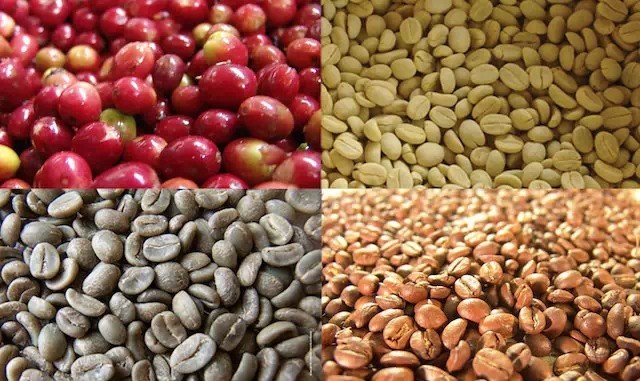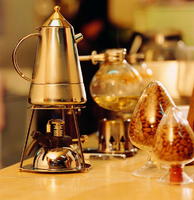Introduction to grinding, storage, baking and planting of coffee beans
Grinding and Storage of Coffee beans
Proper grinding is related to the success or failure of a cup of coffee, no matter what brewing method has its correct extraction standard, which can also be called the mass of water molecules in coffee beans. The simple rule is that the shorter the brewing time is, the finer the grinding scale is. In addition, the same operation mode, the amount of brewing weight, in order to achieve a balanced operation quality, it is also necessary to properly adjust the grinding scale. Different grinding designs also lead to different grinding effects, according to the needs of its operation, choose the appropriate grinding tooth disk (blade), the appropriate motor speed, will greatly improve the taste of coffee.
Choose the right packaging or container and store it in the right space, that's what it is, but fresh coffee is extremely sensitive to the storage environment. In recent years, experts strongly recommend the use of aluminum foil packaging material (opaque) with one-way exhaust valve, which is praised and recognized by large manufacturers at home and abroad, blocking the invasion of oxygen and being able to exhaust carbon dioxide, greatly prolonging the honeymoon period of tasting fresh coffee. As for storage, I think it only needs to be placed in the shade where it is not susceptible to moisture and does not have direct sunlight. Refrigeration or freezing is not absolutely ideal. Excessive shrinkage of fiber, condensation of benign oil, peculiar smell in the refrigerator, and temperature difference during extraction are all thought-provoking, aren't they?
Roasting of coffee beans:
The more common distinguishing methods are cinnamon baking (Cinnamon Roast), metropolitan baking (City Roast), universal baking (Full-City Roast), Viennese baking (Vienna Roast), Italian baking (Italian Roast) and French baking (French Roast).
The selection of raw beans, mastering the characteristics and structure of the roaster, and patiently repeating tests are the only way for a successful baker. The change of air and humidity in the working environment, the appropriate time for raw materials to enter the pot, the precise control of the heating procedure and time, how to adjust the exhaust gas valve, the cooling system and program, and even calculate the moving rate of each coffee bean in the boiler, have fully given coffee active vitality.
Cup test of coffee beans:
It is definitely a hard task, mainly to determine which beans are suitable to apply in order to achieve the best results, in line with the appropriate time to create the environment and the physiological state of the testers.
The ratio of quantitative coffee to boiling water, accurate grinding, standard water temperature and the same soaking time, and then the testers did their best to find out the defects without talking and quickly recorded them to ensure that some beginners were dumbfounded. The cup test is full of ugliness, the reason is that the vacuum method is used to absorb a mouthful of coffee straight to the root of the tongue and instantly feel the basic taste of sour / sweet / bitter / astringent. If not for professionals, it may not be easy to complete a certain number of accurate tests in a short period of time.
The planting of coffee beans
It is difficult to think that coffee will be the core of the fruit growing on the tree. like other agricultural products, different producing areas will give birth to different flavors, and the main reasons for changing its flavor are not only different farms have their own planting methods, but also climate, rainfall, humidity, and even soil, fertile volcanic rock areas or fragile red soil, creating a lively and attractive vitality of coffee.
Coffee Arabica means the highest quality coffee in the world. The ideal planting sites are located in the circular zone of the Tropic of Cancer (between 25 degrees north and south) and in mountainous areas or subtropics that are not easy to frost. The more representative items are Costa Rica and Guatemala in Central America, Colombia and Brazil in South America, Kenya and Ethiopia in Africa, Sumatra and Mantlin in Indonesia, etc. Its output accounts for about 7080% of the world's total output.
Coffee Robusta accounts for about 2030% of the world's total output. Compared with Arabica, it belongs to lowland cultivation. It is resistant to high temperature, drought, rain, pests and strong adaptability. It is the most abundant of the three original species of coffee, and it lacks sour taste, bitterness and aroma. It is also a great pity for Romsda. It is mainly produced in African countries such as Ivory Sea, Angola, Madagascar and so on. Philipin, Indonesia (Java), India, etc., are also the main planting sites.
Liberia (Coffee Liberica) due to poor quality, the planting proportion has been much lower than before, only a small number of producing countries drink on their own, such as Libya, Angola and so on.
Source: people's Daily online
Important Notice :
前街咖啡 FrontStreet Coffee has moved to new addredd:
FrontStreet Coffee Address: 315,Donghua East Road,GuangZhou
Tel:020 38364473
- Prev

Raw Bean Label: Interpretation of Common Abbreviations in English
Pay attention to the raw bean information. In addition to the country and region name at a glance, the label often contains many abbreviations. When you first meet, you often don't know what to say: DP: Dry Process, EP: European Preparation, European Standard. It is common in South America. In order to meet the special requirements of some European green bean merchants, on the basis of the classification of green beans
- Next

Strategies for brewing coffee-what's the difference between different brewing methods?
Siphon pot (Syphon) is one of the most popular coffee brewing methods in cafes. Principle of siphon pot: under the combustion of alcohol lamp, when the water temperature in the lower container reaches 92 ℃, the water is sucked into the upper container with coffee powder, and after soaking and stirring, the coffee is returned. Suitable for coffee: slightly sour, medium-bodied coffee. Degree of grinding: slightly thicker than powder
Related
- What is the meaning of lactic acid fermentation with coffee bean treatment?
- How to judge the state of foam by sound?
- How does the latte pull out the unicorn pattern? Come to get for a little trick to improve the flower pull!
- Will flower pulling affect the taste of the latte?
- Do you know the history of coffee?
- The difference between honey treatment and sun washing what is raisin honey treatment?
- What kind of milk can a novice use to make coffee foam to keep the foam longer? The correct method and skills of milking tutorial sharing
- Why do washed coffee beans taste sour? Flavor characteristics of washed Coffee
- Introduction to the skill of how to practice the size and height of water injection around the circle of hand-brewed coffee
- How do beginners practice coffee flower drawing from scratch?

